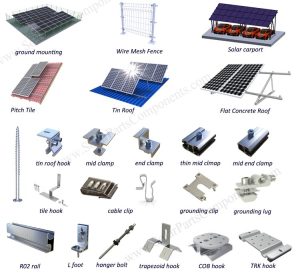What Are the Accessories Used in a Solar PV System?
What Are the Accessories Used in a Solar PV System?
A solar PV system uses a number of accessories to operate efficiently. These include a monitoring system, disconnect switch and circuit breaker.
A battery allows a solar system to store energy and work during power cuts. This reduces energy import from the grid and saves money.
Bird-proofing solutions prevent birds from nesting underneath the panels, reducing damage and maintenance costs. It is best to install these at the time of initial installation.
Battery
An important part of a solar power system is the battery. Batteries are a good option for homeowners who want to reduce their dependency on the grid and increase their energy independence, but they must be properly sized. Otherwise, they may not provide enough backup power. In addition, batteries should be inspected regularly and kept at the temperature recommended by the manufacturer.
A photovoltaic accessories manufacturer consists of an array of components including solar panels to absorb sunlight and convert it into electricity, a charge controller to regulate the flow of power from the solar panel to the batteries, and an inverter to change the DC output from the solar panels into alternating current. Additionally, it includes mounting structures to secure the solar panels to the roof or ground and wiring to transport the generated power to where it is needed.
Solar accessories, such as MC4 connectors, Anderson plugs, PV cable, fuses, and isolation cables are also necessary for a successful solar installation. These tools help fight against environments that can negatively impact the performance of a PV system. For example, USFULL’s MC4 Connector is environmentally friendly and has a thick copper core that can withstand high temperatures. It is also durable and has a self-locking design, making it easy to use. In addition, it is available in a variety of sizes and voltages.
EV Charger
The EV charger is an essential accessory that is used to convert the DC (direct current) power from the solar panels into AC (alternating current) electricity, which can then be used in your home. It is also a backup power source when the PV system is not producing electricity for one reason or another, like a cloudy day or if the grid power fails.
MC4 Connectors are the standard connector for connecting solar panels to an inverter. They have strong self-locking pins and use waterproof, high-strength, pollution-free PPO material. They also feature copper which is the best conductor of electricity. These connections help reduce losses and are easy to install on any type of roof, including flat ones.

A charge controller is another important accessory that helps to ensure that the batteries are not overcharged or undercharged. It is a good idea to go with an MPPT charge controller instead of a PWM because it will allow your batteries to absorb more energy from the solar panels and can result in up to 25% more power than a PWM controller.
A battery storage system is an excellent way to cut your power bills and reduce your dependence on the grid. It can provide backup during a power outage, cut your electricity importing costs, and even let you benefit from time-of-use tariffs.
Bird Proofing Solutions
Bird droppings can damage your solar panel installation, especially if it is roof mounted. They are corrosive and can damage the surface and impact the efficiency of your solar panels. They can also block sunlight if they build nests underneath. It’s important to protect your investment with effective preventive measures.
There are a variety of solutions for protecting your solar panels, including bird spikes, netting and more. These are designed to be a humane solution for deterring birds without harming them.
Netting is a popular choice as it is a simple at-home DIY project and provides long-term protection. It’s available in various colours to match the solar panels and is durable, easy to install and UV resistant.
Another option is a specialist solar-panel bird deterrent kit, like the Bird-Flite or AVIX Autonomic Mark II. This is a specialised stainless steel guard that is not visible from ground level and discourages pigeons and other pest birds from getting under the solar panels, preventing them from destroying the roofing tiles and electrical wiring. It uses green laser light to deter the birds and does not repeat, so they do not become accustomed to it. This system can be programmed and monitored via a user-friendly app. It is a cost-effective way to protect your solar investment.
Inverter
The solar inverter converts DC (direct current) energy from the PV modules into AC (alternating current) electricity for use in homes and businesses. It also regulates the flow of power into and from the battery bank. It’s important to choose an inverter that is rated to match the size of your system, as well as its design and layout.
There are a few different types of solar inverters on the market, including string inverters, micro inverters and hybrid inverters. Solar inverters are available with both manual and smart controls, depending on your needs.
An inverter can be paired with storage batteries to allow the solar system to operate during a power outage. It can be configured in a series, parallel or series-parallel connection to the battery bank depending on your system design.
Solar accessories include MC4 connectors, extension cables, monitoring systems, AC/DC disconnects and racking mounts. Some of these accessories are required for every PV solar system, while others may be optional depending on the layout. For example, a monitoring system can help you track performance over time and identify potential problems. It can also show you how much energy your solar panel is producing at any given point in time. Another accessory is an immersion diverter, which allows excess energy to be used to heat your hot water tank, instead of wasting it on the grid.